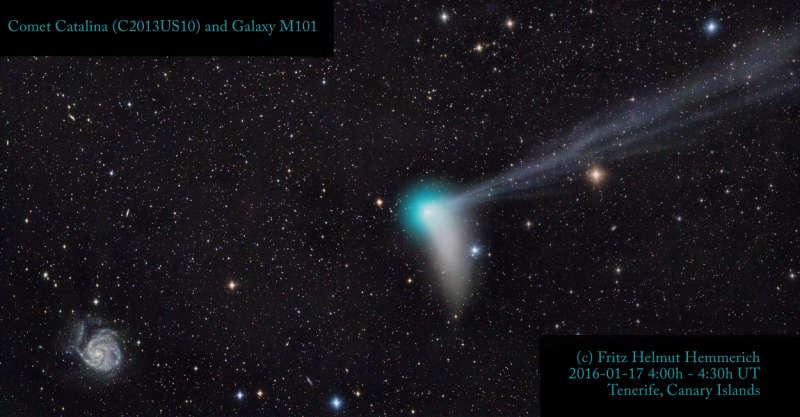Credit & Copyright: Fritz
Helmut Hemmerich
Explanation:
Sweeping through northern skies, Comet Catalina (C/2013 US10) made its
closest approach on January 17, passing about 6 light-minutes
from our fair planet.
Dust and ion tails clearly separated
in this Earth-based view,
the comet is also posed for a
Messier moment, near the line-of-sight
to M101, grand spiral galaxy in Ursa Major.
A cosmic pinwheel
at the lower left, M101 is nearly twice the size of our own
Milky Way galaxy, but some 270 thousand light-centuries away.
Both galaxy and comet are relatively bright, easy targets for
binocular-equipped skygazers.
But Comet Catalina
is now outbound from the inner
Solar System
and will slowly fade in coming months.
This
telescopic two panel mosaic spans about 5 degrees (10 Full Moons)
on the sky.
1999 2000 2001 2002 2003 2004 2005 2006 2007 2008 2009 2010 2011 2012 2013 2014 2015 2016 2017 2018 2019 2020 2021 2022 2023 2024 2025 |
Yanvar' Fevral' Mart Aprel' Mai Iyun' Iyul' Avgust Sentyabr' Oktyabr' Noyabr' Dekabr' |
NASA Web Site Statements, Warnings, and Disclaimers
NASA Official: Jay Norris. Specific rights apply.
A service of: LHEA at NASA / GSFC
& Michigan Tech. U.
|
Publikacii s klyuchevymi slovami:
comet - komety - kometnye hvosty - spiral'naya galaktika
Publikacii so slovami: comet - komety - kometnye hvosty - spiral'naya galaktika | |
Sm. takzhe:
Vse publikacii na tu zhe temu >> | |
